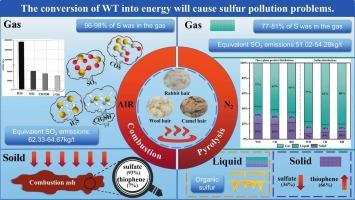Unveiling the migration and transformation pathways of sulfur during combustion and pyrolysis of waste textiles
IF 4.3
2区 工程技术
Q2 ENGINEERING, CHEMICAL
引用次数: 0
Abstract
Converting of waste textiles (WT) into fuel is considered one of the feasible pathways to promote the circular economy of textile industry, at which the sulfur problem is unknown. In this study, we tried to unveil the sulfur problem during the combustion/pyrolysis process of WT, including wool hair (WH), camel hair (CH) and rabbit hair (RH) by thermogravimetry-mass spectrum simulation and batch experiments. Results showed that CH and WH showed the best combustion and pyrolysis possibility, based on their TG-DTG curves and thermal characteristic parameters. The sulfur-containing gas mainly emitted as H2S and SO2 during WT combustion and pyrolysis, therein, combustion was conducive to the release of sulfur. Regardless of combustion or pyrolysis, standardized SO2 outputs lied at nonnegligible level (62.33––64.67 kg/t from combustion and 51.02––54.28 kg/t from pyrolysis). Correspondingly, only 4 % of sulfur was trapped in WT combustion ash as sulfate form, while approximately 23 % sulfur was trapped in pyrolytic char and tar phases as organic sulfur forms (e.g. thiophene, ether, acid and ester). This study unveils a neglected sulfur during combustion and pyrolysis of waste textiles.

揭示了废纺织品燃烧热解过程中硫的迁移转化途径
废纺织品转化为燃料被认为是促进纺织工业循环经济的可行途径之一,其中硫问题是未知的。在本研究中,我们试图通过热重-质谱模拟和批量实验来揭示WT(包括羊毛(WH)、驼毛(CH)和兔毛(RH))燃烧/热解过程中的硫问题。结果表明,从TG-DTG曲线和热特性参数来看,CH和WH的燃烧和热解可能性最好。在WT燃烧和热解过程中,含硫气体主要以H2S和SO2的形式释放,其中燃烧有利于硫的释放。无论燃烧还是热解,标准化的SO2产量都处于不可忽略的水平(燃烧产生62.33—64.67 kg/t,热解产生51.02—54.28 kg/t)。相应地,只有4% %的硫以硫酸盐形式被捕获在WT燃烧灰中,而大约23% %的硫以有机硫形式(如噻吩、醚、酸和酯)被捕获在热解炭和焦油相中。本研究揭示了废纺织品燃烧和热解过程中被忽视的硫。
本文章由计算机程序翻译,如有差异,请以英文原文为准。
求助全文
约1分钟内获得全文
求助全文
来源期刊

Chemical Engineering Science
工程技术-工程:化工
CiteScore
7.50
自引率
8.50%
发文量
1025
审稿时长
50 days
期刊介绍:
Chemical engineering enables the transformation of natural resources and energy into useful products for society. It draws on and applies natural sciences, mathematics and economics, and has developed fundamental engineering science that underpins the discipline.
Chemical Engineering Science (CES) has been publishing papers on the fundamentals of chemical engineering since 1951. CES is the platform where the most significant advances in the discipline have ever since been published. Chemical Engineering Science has accompanied and sustained chemical engineering through its development into the vibrant and broad scientific discipline it is today.
 求助内容:
求助内容: 应助结果提醒方式:
应助结果提醒方式:


